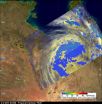(Press-News.org) OAK RIDGE, Tenn. Feb. 3, 2011 -- Researchers at the Department of Energy's Oak Ridge National Laboratory have developed a biohybrid photoconversion system -- based on the interaction of photosynthetic plant proteins with synthetic polymers -- that can convert visible light into hydrogen fuel.
Photosynthesis, the natural process carried out by plants, algae and some bacterial species, converts sunlight energy into chemical energy and sustains much of the life on earth. Researchers have long sought inspiration from photosynthesis to develop new materials to harness the sun's energy for electricity and fuel production.
In a step toward synthetic solar conversion systems, the ORNL researchers have demonstrated and confirmed with small-angle neutron scattering analysis that light harvesting complex II (LHC-II) proteins can self-assemble with polymers into a synthetic membrane structure and produce hydrogen.
The researchers envision energy-producing photoconversion systems similar to photovoltaic cells that generate hydrogen fuel, comparable to the way plants and other photosynthetic organisms convert light to energy.
"Making a, self-repairing synthetic photoconversion system is a pretty tall order. The ability to control structure and order in these materials for self-repair is of interest because, as the system degrades, it loses its effectiveness," ORNL researcher Hugh O'Neill, of the lab's Center for Structural Molecular Biology, said.
"This is the first example of a protein altering the phase behavior of a synthetic polymer that we have found in the literature. This finding could be exploited for the introduction of self-repair mechanisms in future solar conversion systems," he said.
Small angle neutron scattering analysis performed at ORNL's High Flux Isotope Reactor (HFIR) showed that the LHC-II, when introduced into a liquid environment that contained polymers, interacted with polymers to form lamellar sheets similar to those found in natural photosynthetic membranes.
The ability of LHC-II to force the assembly of structural polymers into an ordered, layered state -- instead of languishing in an ineffectual mush -- could make possible the development of biohybrid photoconversion systems. These systems would consist of high surface area, light-collecting panes that use the proteins combined with a catalyst such as platinum to convert the sunlight into hydrogen, which could be used for fuel.
The research builds on previous ORNL investigations into the energy-conversion capabilities of platinized photosystem I complexes -- and how synthetic systems based on plant biochemistry can become part of the solution to the global energy challenge.
"We're building on the photosynthesis research to explore the development of self-assembly in biohybrid systems. The neutron studies give us direct evidence that this is occurring," O'Neill said.
The researchers confirmed the proteins' structural behavior through analysis with HFIR's Bio-SANS, a small-angle neutron scattering instrument specifically designed for analysis of biomolecular materials.
"Cold source" neutrons, in which energy is removed by passing them through cryogenically chilled hydrogen, are ideal for studying the molecular structures of biological tissue and polymers.
The LHC-II protein for the experiment was derived from a simple source: spinach procured from a local produce section, then processed to separate the LHC-II proteins from other cellular components. Eventually, the protein could be synthetically produced and optimized to respond to light.
O'Neill said the primary role of the LHC-II protein is as a solar collector, absorbing sunlight and transferring it to the photosynthetic reaction centers, maximizing their output. "However, this study shows that LHC-II can also carry out electron transfer reactions, a role not known to occur in vivo," he said.
The research team, which came from various laboratory organizations including its Chemical Sciences Division, Neutron Scattering Sciences Division, the Center for Structural Molecular Biology and the Center for Nanophase Materials Sciences, consisted of O'Neill, William T. Heller, and Kunlun Hong, all of ORNL; Dimitry Smolensky of the University of Tennessee; and Mateus Cardoso, a former postdoctoral researcher at ORNL now of the Laboratio Nacional de Luz Sincrotron in Brazil.
"That's one of the nice things about working at a national laboratory. Expertise is available from a variety of organizations," O'Neill said.
INFORMATION:
The work, published in the journal Energy & Environmental Science, was supported with Laboratory-Directed Research and Development funding. HFIR is supported by the DOE Office of Science.
ORNL is managed by UT-Battelle for the Department of Energy's Office of Science.
NOTE TO EDITORS: You may read other press releases from Oak Ridge National Laboratory or learn more about the lab at http://www.ornl.gov/news. Additional information about ORNL is available at the sites below:
Twitter - http://twitter.com/oakridgelabnews
RSS Feeds - http://www.ornl.gov/ornlhome/rss_feeds.shtml
Flickr - http://www.flickr.com/photos/oakridgelab
YouTube - http://www.youtube.com/user/OakRidgeNationalLab
LinkedIn - http://www.linkedin.com/companies/oak-ridge-national-laboratory
Facebook - http://www.facebook.com/Oak.Ridge.National.Laboratory
Image: http://www.ornl.gov/info/press_releases/photos/LHCII.jpg
Caption: Neutron scattering analysis performed at DOE's Oak Ridge National Laboratory reveals the lamellar structure of a hydrogen-producing, biohybrid composite material formed by the self-assembly of naturally occurring, light harvesting proteins with polymers.
'Tall order' sunlight-to-hydrogen system works, neutron analysis confirms
2011-02-04
ELSE PRESS RELEASES FROM THIS DATE:
Loss of oyster reefs a global problem, but one with solutions
2011-02-04
(February 3, 2011) Those familiar with Chesapeake Bay know that its once-vast oyster population stands at a tiny fraction of its historical abundance. A new study by an international team including professor Mark Luckenbach of the Virginia Institute of Marine Science shows that the decline of oyster reefs is not just a local problem.
The team's global comparison of oyster reefs past and present shows that oyster reefs are at less than 10% of their prior abundance in 70% of the 144 bays studied, ranging from China to England to Australia to Brazil. Overall, they estimate ...
Future surgeons may use robotic nurse, 'gesture recognition'
2011-02-04
WEST LAFAYETTE, Ind. -- Surgeons of the future might use a system that recognizes hand gestures as commands to control a robotic scrub nurse or tell a computer to display medical images of the patient during an operation.
Both the hand-gesture recognition and robotic nurse innovations might help to reduce the length of surgeries and the potential for infection, said Juan Pablo Wachs, an assistant professor of industrial engineering at Purdue University.
The "vision-based hand gesture recognition" technology could have other applications, including the coordination of ...
Morning-after spike in ozone air pollution from Super Bowl XLV?
2011-02-04
WASHINGTON, Feb. 3, 2011 — Not even the most avid fans could notice, but those spectacular aerial images of a brightly-lit Cowboys Stadium during Sunday's Super Bowl XLV symbolize one of the hottest new pieces of scientific intelligence about air pollution:
Researchers have discovered — in a classic case of scientific serendipity — that the bright light from sports stadiums and urban street lights may boost daytime levels of ozone, a key air pollutant in many heavily populated areas. That's among the topics included in a broader article about the chemistry of air pollution ...
Scientists urge new research policies in wake of Gulf disaster
2011-02-04
CORVALLIS, Ore. – Scientists are having a difficult time gauging the recovery of marine species from the Deepwater Horizon oil spill in the Gulf of Mexico because they lack sufficient data about historical population size and the distribution, growth rates and reproduction rates of many species.
In a forum paper published this week in the journal Science, they call for a new research agenda that prioritizes systematic acquisition of baseline data for marine species.
"It is impossible to diagnose whether a species is recovering or floundering if you don't have good data ...
Oil in Gulf of Mexico: Biologists cite need for critical data to determine ecological consequences
2011-02-04
GAINESVILLE, Fla. — Twenty years after biologists attempted to determine the ecological damages to marine life from the Exxon Valdez oil spill, scientists dealing with the BP disaster find themselves with the same problem: the lack of critical data to determine the ecological consequences of human-induced environmental disasters, a University of Florida researcher said.
Writing in the Feb. 4 issue of the journal Science, Karen A. Bjorndal, a University of Florida biology professor and director of the Archie Carr Center for Sea Turtle Research, and other biologists said ...
New clue to lupus: Failed autoimmune suppression mechanism
2011-02-04
Bar Harbor, Maine — Researchers at Dana-Farber Cancer Institute in Cambridge, Mass., in collaboration with Jackson Laboratory scientists, have identified a regulatory defect that drives lupus.
Correcting the defect "may represent an effective therapeutic approach to systemic lupus erythematosus-like autoimmune disease," the researchers state in their research paper, published in the Proceedings of the National Academy of Sciences. The research team was led by Harvey Cantor, M.D., chair of the department of cancer immunology and AIDS at Dana-Farber, in collaboration with ...
Surprise hidden in Titan's smog: Cirrus-like clouds
2011-02-04
Every day is a bad-air day on Saturn's largest moon, Titan. Blanketed by haze far worse than any smog belched out in Los Angeles, Beijing or even Sherlock Holmes's London, the moon looks like a dirty orange ball. Described once as crude oil without the sulfur, the haze is made of tiny droplets of hydrocarbons with other, more noxious chemicals mixed in. Gunk.
Icky as it may sound, Titan is really the rarest of gems: the only moon in our solar system with an atmosphere worthy of a planet. This atmosphere comes complete with lightning, drizzle and occasionally a big, summer-downpour ...
NASA measuring Tropical Storm Yasi's inland rainfall from space
2011-02-04
Tropical Cyclone Yasi has continued moving through inland Queensland, Australia and has weakened to a tropical depression today. NASA and JAXA's TRMM satellite passed over Yasi as it continued to drop moderate to heavy rainfall.
On February 3 at 0300 UTC (Feb. 2 at 10 p.m. EST/1 p.m. Australia local time) Tropical cyclone Yasi continued over land as a tropical storm. Yasi's maximum sustained winds were near 60 knots (69 mph/111 kmh). It was moving west-southwest near 20 knots/23 mph/37 kmh). It was located about 200 miles (321 km) southwest of Cairns, Australia near ...
OHSU fixes complex heart problems without open-heart surgery
2011-02-04
PORTLAND, Ore. -- The pediatric cardiac team at Oregon Health & Science University Doernbecher Children's Hospital is the first in the region and one of a handful in the nation to implant a pulmonary heart valve without open-heart surgery.
To date, four patients have received the landmark valve in the OHSU Pediatric and Adult Congenital Cardiac Catheterization Lab. All reported immediate improvement in their energy level and stamina.
The device, called the Medtronic Melody® Transcatheter Pulmonary Valve, recently was approved by the Food and Drug Administration. The ...
Cornell researchers find a strong community protects adolescents from risky health behavior
2011-02-04
ITHACA, N.Y. – Growing up poor increases a person's likelihood of health problems as an adult, but a new study led by a Cornell University environmental psychologist shows that being raised in a tight-knit community can help offset this disadvantage of poverty.
The study, "Loosening the Link Between Childhood Poverty and Adolescent Smoking and Obesity : The Protective Effects of Social Capital" published in the January 2011 edition of the peer-reviewed journal Psychological Science, found that poor adolescents who live in communities with more social cohesiveness are ...


